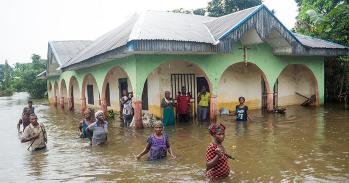
Assessing the chance of something happening or not happening confronts us all the time. A new programme led by David Spiegelhalter, the Winton Professor of the Public Understanding of Risk, is helping improve people's understanding of the mathematics of risk.
Assessing the chance of something happening or not happening confronts us all the time. A new programme led by David Spiegelhalter, the Winton Professor of the Public Understanding of Risk, is helping improve people's understanding of the mathematics of risk.
An important consideration for statisticians must therefore be to develop an understanding of the social basis for attitudes to risk and uncertainty, and to maintain a two-way communication with the general public, students, scientists, media and policy-makers.
We all have to live with not knowing what is going to happen (what will the climate be like in 2050, when will I die, will the stock market crash?), what is happening (what is the current number of unemployed, do I have a tumour?), and what has happened (how many people did Harold Shipman murder, what caused my child’s illness?). We learn to deal with this pervasive uncertainty, but potential threats to our well-being understandably make us uncomfortable, particularly when the risks seem poorly understood or are imposed by others. In all this anxiety and even dread, the ability to carefully analyse risks in a formal way can be overlooked.
Different people react to risks in different ways; it isn’t enough to lecture people on probability and statistics and expect them to suddenly become ‘rational’. An important consideration for statisticians must therefore be to develop an understanding of the social basis for attitudes to risk and uncertainty, and to maintain a two-way communication with the general public, students, scientists, media and policy-makers. This is the premise for a new programme at the University of Cambridge that will seek to help individuals, institutions and government to understand the possible consequences of their decisions in risky situations. The Winton Programme for the Public Understanding of Risk is funded by a £3.3 million donation from The Winton Charitable Foundation. Appropriately, since the theory of probability is the scientific language of uncertainty, the programme is based in the Statistical Laboratory in the Centre for Mathematical Sciences (CMS).
Understanding uncertainty
Uniquely, the Winton Programme is trying to service multiple audiences. The intention is to engage the public by introducing issues through stories, attractive graphics and entertaining animations, but then providing optional additional levels of mathematical analysis, ranging from arithmetic, through basic algebra and probability theory, to full technical explanations. Key to accomplishing this is the website, launched this May, which is intended to be not only interactive, authoritative and fun, but also an international resource for all aspects of the quantitative handling of uncertainty. The team behind the website includes web designers and animators Mike Pearson and Owen Smith, and social scientists Hauke Riesch and Arciris Garay-Arevalo.
Working with the media
The media clearly play a vital role in the perception of risk and how different risks might affect us in our everyday lives. In the past six months alone, we’ve been confronted with stories in newspapers or on television about the risks of middle-class drinking, obesity, getting cancer from bacon sandwiches, and so on. Many stories suffer predictable but major distortions in the passage from scientific study, through press release, to presentation in the media. An important factor in achieving the necessary link between statistical analysis and the general public is therefore to establish a good working relationship with the media. The team’s work has already been featured in a number of radio programmes and newspaper articles, not only on issues such as crime statistics or the obesity epidemic (BBC Radio 4), but also on more popular items such as the potential benefits of New Year’s resolutions (The Sun newspaper).
Putting a risky future in perspective
The Winton Programme comes at a time when public, institutional and governmental awareness is highly receptive to issues of risk. Formal quantitative approaches to risk and uncertainty are of potentially great benefit both to individuals and to society, but it cannot be assumed that we can simply put a number on our uncertainty and thereby calculate the correct decision: it requires care and judgement to find the appropriate role for probabilistic reasoning in everyday life.
Communicating Risk
One part of the new initiative relates to the communication of risk. 'I went to my GP recently and we put my blood pressure, cholesterol etc, into a risk equation and out popped the assessment that I had a 10% chance of a heart attack or stroke in the next 10 years,' said Professor Spiegelhalter. 'This was sobering news. We want to extend the usefulness of this kind of analysis to allow people to get to grips with the influence lifestyle may have on their future prospects.'
The team have created an animated graph relating lifestyle factors to current survival rates in the UK, using data collected by the Institute of Public Health in Cambridge through the EPIC-Norfolk study (www.srl.cam.ac.uk/epic). The study followed up 20,000 people in Norfolk to determine how different behaviours (smoking, drinking, diet and exercise) can affect survival. As an example, the survival prospects of a physically active, non-smoking 54-year-old who eats five fruit or vegetables a day and drinks only moderate amounts of alcohol are 12 years longer than someone of similar age who smokes, drinks over the recommended limits, does not exercise and has a poor diet. The risks are clear from the animated graphs. This simple animation allows people to ‘play’ with changing lifestyle in relation to age and is available on the programme website.
League tables and ‘rare’ events
As an example of the type of resource the programme website will host, the team have animated the entire history of the UK’s National Lottery to illustrate the fact that spurious ‘league tables’ can be constructed from situations involving pure randomness, and that rankings of schools, sports teams, hospitals, or even universities can also be heavily influenced by chance.
Between February and November 2000 there was an extraordinary interval of 72 draws when ball number 17 never appeared as a winning (non-bonus) number in the National Lottery. At face value this is a very rare event (with a chance of around 1/12,500). But, because over 7000 balls have been drawn since the start of the lottery, the statistics show that this maximum gap is almost exactly what would be expected by chance alone. The animation provides a good demonstration that apparently very rare events are likely to happen when given enough opportunities. ‘We’ve also animated results from Premier League football and shown that half the spread of points is due to chance alone,’ said Professor Spiegelhalter. ‘This goes down well in all the schools’ talks we are doing.’
For more information, please contact: the author Professor David Spiegelhalter (D.Spiegelhalter@statslab.cam.ac.uk) at the Statistical Laboratory.
Professor Spiegelhalter is also Senior Scientist in the MRC Biostatistics Unit in Cambridge, which develops statistical methods to advance understanding of the cause, natural history and treatment of disease.
This work is licensed under a Creative Commons Licence. If you use this content on your site please link back to this page.





